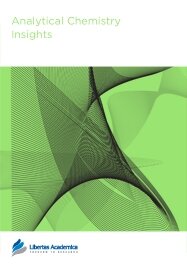

Publication Date: 29 Aug 2008
Journal: Analytical Chemistry Insights

A simple high sensitive, selective, and rapid spectrophotometric method for the determination of trace gold based on the rapid reaction of gold(III) with bis(salicylaldehyde)orthophenylenediamine (BSOPD) in aqueous and micellar media has been developed. BSOPD reacts with gold(III) in slightly acidic solution to form a 1:1 brownish-yellow complex, which has an maximum absorption peak at 490 nm in both aqueous and micellar media. The most remarkable point of this method is that the molar absorptivities of the gold-BSOPD complex form in the presence of the nonionic TritonX-100 surfactant are almost a 10 times higher than the value observed in the aqueous solution, resulting in an increase in the sensitivity and selectivity of the method. The apparent molar absorptivities were found to be 2.3 × 104 L mol−1 cm−1 and 2.5 × 105 L mol−1 cm−1 in aqueous and micellar media, respectively. The reaction is instantaneous and the maximum absorbance was obtained after 10 min at 490 nm and remains constant for over 24 h at room temperature. The linear calibration graphs were obtained for 0.1 –30 mg L−1 and 0.01 –30 mg L−1 of gold(III) in aqueous and surfactant media, respectively. The interference from over 50 cations, anions and complexing agents has been studied at 1 mg L−1 of Au(III); most metal ions can be tolerated in considerable amounts in aqueous micellar solutions. The Sandell’s sensitivity, the limit of detection and relative standard deviation (n = 9) were found to be 5 ng cm−2, 1 ng mL−1 and 2%, respectively in aqueous micellar solutions. Its sensitivity and selectivity are remarkably higher than that of other reagents in the literature. The proposed method was successfully used in the determination of gold in several standard reference materials (alloys and steels), environmental water samples (potable and polluted), and biological samples (blood and urine), geological, soil and complex synthetic mixtures. The results obtained agree well with those samples analyzed by atomic absorption spectrophotometry (AAS).
PDF (505.61 KB PDF FORMAT)
RIS citation (ENDNOTE, REFERENCE MANAGER, PROCITE, REFWORKS)
BibTex citation (BIBDESK, LATEX)

I have published more than thirty research papers in internationally reputed high impact factor journals including Libertas Academica publications, Proteomics Insights and Analytical Chemistry Insights. I have no hesitation in saying that Proteomics Insights is highly efficient for its rapid and high quality review process and keeping the authors informed at each stage of the publication process. I recommend this journal for students, teachers and research workers who wish to publish their work. ...

All authors are surveyed after their articles are published. Authors are asked to rate their experience in a variety of areas, and their responses help us to monitor our performance. Presented here are their responses in some key areas. No 'poor' or 'very poor' responses were received; these are represented in the 'other' category.See Our Results
Copyright © 2013 Libertas Academica Ltd (except open access articles and accompanying metadata and supplementary files.)
FacebookGoogle+Twitter
PinterestTumblrYouTube